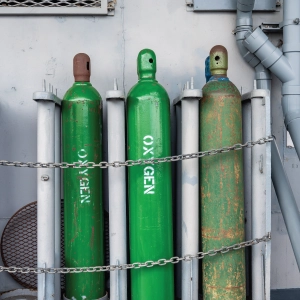HAZMAT and HAZWOPER: What is the Difference?

For employers and employees working with hazardous materials, dangerous substances, and other toxic chemicals, HAZMAT and HAZWOPER are important terms to note. Some workers may even use these acronyms interchangeably, which is not accurate. This can cause confusion amongst workers, especially when it comes to fulfilling job training requirements. With the many training courses required by the different agencies and regulatory bodies, choosing the correct training is important but also sometimes complicated for first-time employees working in hazardous waste operations or working with hazardous materials.
We will try to de-mystify the terms HAZMAT and HAZWOPER, and also discuss the different online training programs available for employees working with hazardous wastes and hazardous materials.
What is HAZWOPER?
HAZWOPER stands for Hazardous Waste Operations and Emergency Response, a standard developed and managed by the Occupational Safety and Health Administration (OSHA). The HAZWOPER Standard aims to offer comprehensive guidance on worker safety and health when they handle or use HAZMAT, hazardous waste, or engage in emergency operations related to hazardous waste cleaning. So, essentially, HAZWOPER is the set of rules and regulations that provide guidance on the proper handling, storage, transportation, and clean-up of any type or form of hazardous materials.
What is HAZMAT?
HAZMAT, however, is an abbreviation commonly used for hazardous material. Sometimes written as HazMat or even hazmat, HAZMAT refers to biological or radiological substances, other toxic chemicals, or even nuclear waste in liquid, solid, gaseous, or any other form that is harmful to the health and safety of people, may cause property damage, or be a risk to the environment. Thus, HAZMAT refers to the hazardous material itself.
Having understood the difference between HAZWOPER and HAZMAT, let us consider how workers working in hazardous waste operations and those working with hazardous materials (HAZMAT) should be trained.
HAZWOPER Training Requirements
As HAZWOPER is an OSHA-developed Standard, it specifies several training requirements for workers employed by hazardous waste site cleanup operations; companies involved in hazardous waste treatment, storage, and disposal (TSD facilities); and emergency response operations involving hazardous substance releases (OSHA, n.d).
OSHA has segregated the HAZWOPER training into three major levels and specified a total of 18 training programs for different levels of exposure to hazardous waste as shown below.
| SECTION (E) | SECTION (P) | SECTION (Q) |
|---|---|---|
| Training for general site workers engaged in operations conducted at hazardous waste sites that may or may not expose them to hazardous substances. | Training for workers engaged in certain hazardous waste operations conducted under the RCRA and at treatment, storage, and disposal (TSD) facilities. | Training for workers engaged in emergency response operations for release of, or substantial threat of release of, hazardous substances without regard to the location of the hazard. |
| Six (6) HAZWOPER training courses fall under this section. | Two (2) HAZWOPER training courses fall under this section. | There are 5 levels of emergency responder training and 10 HAZWOPER training courses fall under this section. |
| 1) 40-Hour HAZWOPER (e) – Initial | 7) 24-hr TSDF Worker (p) – Initial | 9) First Responder Awareness – Initial |
| 2) 24-Hour HAZWOPER (e) – Initial | 8) 8-Hour HAZWOPER (p) – Refresher | 10) First Responder Operations – Initial |
| 3) 16-Hour HAZWOPER (e) – Upgrade | 11) Hazardous Materials Technician – Initial | |
| 4) 8-Hour HAZWOPER Supervisor (e) – Initial | 12) Hazardous Materials Specialist – Initial | |
| 5) 8-Hour HAZWOPER (e) – Refresher | 13) Incident Commander- Initial | |
| 6) 8-Hour HAZWOPER Supervisor (e) – Refresher | 14) First Responder Awareness – Refresher | |
| 15) First Responder Operations – Refresher | ||
| 16) Hazardous Materials Technician – Refresher | ||
| 17) Hazardous Materials Specialist Refresher | ||
| 18) Incident Commander – Refresher |
|
SECTION (E) |
SECTION (P) |
SECTION (Q) |
| Training for general site workers engaged in operations conducted at hazardous waste sites that may or may not expose them to hazardous substances. | Training for workers engaged in certain hazardous waste operations conducted under the RCRA and at treatment, storage, and disposal (TSD) facilities. | Training for workers engaged in emergency response operations for release of, or substantial threat of release of, hazardous substances without regard to the location of the hazard. |
| Six (6) HAZWOPER training courses fall under this section. | Two (2) HAZWOPER training courses fall under this section. | There are 5 levels of emergency responder training and 10 HAZWOPER training courses that fall under this section. |
| 1) 40-Hour HAZWOPER (e) – Initial | 7) 24-hr TSDF Worker (p) – Initial | 9) First Responder Awareness – Initial |
| 2) 24-Hour HAZWOPER (e) – Initial | 8) 8-Hour HAZWOPER (p) – Refresher | 10) First Responder Operations – Initial |
| 3) 16-Hour HAZWOPER (e) – Upgrade | 11) Hazardous Materials Technician – Initial | |
| 4) 8-Hour HAZWOPER Supervisor (e) – Initial | 12) Hazardous Materials Specialist – Initial | |
| 5) 8-Hour HAZWOPER (e) – Refresher | 13) Incident Commander- Initial | |
| 6) 8-Hour HAZWOPER Supervisor (e) – Refresher | 14) First Responder Awareness – Refresher | |
| 15) First Responder Operations – Refresher | ||
| 16) Hazardous Materials Technician – Refresher | ||
| 17) Hazardous Materials Specialist Refresher | ||
| 18) Incident Commander – Refresher |
The most basic of these training programs and one that the majority of workers working for HAZWOPER operations will undoubtedly undergo is the OSHA HAZWOPER 40-Hour initial training course. The other training programs are specific to supervisors, emergency responders, and those working with hazardous materials. Workers are also required to undergo annual HAZWOPER refresher training to ensure their knowledge remains relevant and up-to-date.
RCRA Training
As hazardous wastes are also under the purview of the U.S. Environmental Protection Agency (EPA), the EPA has developed the Resource Conservation and Recovery Act (RCRA) to help with the proper management of hazardous and non-hazardous solid waste. The EPA has the authority to control hazardous waste across all stages of existence, from generation through to its treatment, storage, and disposal. In effect, the EPA takes a ‘cradle-to-grave’ approach to hazardous waste management. Thus, employees working in hazardous waste operations must understand and comply with these rules, regulations, and guidelines. Resultantly, there is a dedicated RCRA Hazardous Waste Generator Training and RCRA Hazardous Waste Generator Refresher Training for employees involved in hazardous waste operations.
HAZMAT Training
As HAZMAT means hazardous materials, is there any specific training that employees must undergo? It is worth noting that any workers working in any industry, including construction, mining, medical, maritime, and shipbuilding; and expected to work with hazardous materials such as asbestos, hydrogen sulfide, silica, lead, bloodborne pathogens, etc., must be trained and aware of the dangers of working with hazardous substances and chemicals as well as methods to reduce exposure.
DOT HAZMAT Training
Then, there is also DOT HAZMAT training. Sometimes industry professionals may refer to this as HAZMAT training, my omitting ‘DOT’.
DOT which is the acronym for the U.S. Department of Transportation has a set of rules and regulations in place for the transportation of hazardous materials by highway, rail, air, or sea. The DOT HAZMAT training gives guidance on how to safely transport hazardous materials in-country as well as the formalities and practices that must be followed when importing and exporting hazardous substances. In effect, the DOT HAZMAT training is function-specific training. Those involved in hazardous waste transport operations must undergo the relevant training to be aware of the relevant regulatory requirements when transporting HAZMAT. Here's the list of DOT Hazmat Transportation Training courses offered by us.
The Right Training for the Right Type of Hazardous Work
First, it is important to understand the different types of training required by the different governing bodies — OSHA’s HAZWOPER Standard, the EPA’s RCRA, and the DOT. Then, depending on the work being carried out as well as the stage at which the worker is involved when handling hazardous wastes, the correct training course must be chosen. Sometimes, to complete all the diverse training requirements required by various job tasks and job roles, workers may have to undertake multiple training courses This will ensure that training covers diverse topics to be fully conversant with the relevant laws, regulations, guidelines, frameworks, systems, and most importantly, relevant health and safety protocols and procedures.
We offer a gamut of HAZWOPER and OSHA-compliant training programs in addition to the RCRA Waste Generator Training courses. Click here for more information.
References
OSHA. (n.d). Hazardous Waste Operations and Emergency Response (HAZWOPER). Background. Website. https://www.osha.gov/emergency-preparedness/hazardous-waste-operations

 EN |
EN |  ES
ES






























































































































